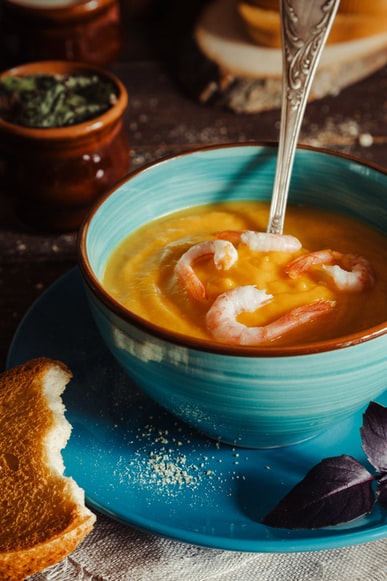Time and time again, the blender has proved that it is a valuable tool in the kitchen because it is excellent for making smoothies, salad dressings, healthy pancakes and waffle batter, homemade applesauce, and so much more. But, no matter how efficient it is, you still have to remember that blending hot foods such as soups or homemade applesauce can be dangerous and can cause burns if no precautions are taken.
This is because when you blend hot foods and put the lid on top of your blender, it tends to heat up the air above the blender lid and the food. This results to pressure build-up in the blender’s jar, which could cause the cover to blow right off and your hot food explode out the top of your blender jar. When this happens, the next thing you will see (and feel) is hot liquid on your hands, the floor, onto your counters, and under your cupboards.
Nobody wants hot soups splashed all over their kitchen. That is why in this article, we are going to talk about how to safely and adequately puree soup and other hot foods using a blender.
Safety Tips When Pureeing Soups and Hot Liquids in a Blender
As we mentioned, when you blend hot liquids in a blender, it will create pressure on the inside of the blender jar, which will blow off its lid. That is why you must take extra care when you’re doing this kind of task.
Probably the easiest solution is to let your soup or whatever you’re cooking cool off before putting it in your blender. Just stir it occasionally while it’s still in the cooking pot to speed the process along. This will re-distribute and release the soup’s heat. However, if you do not want to wait, here are some safety tips that you can do:
- Do not fill the blender all the way in – This is probably the most crucial safety tip that you will need to remember when you’re pureeing soups and other hot liquids in a blender. Fill the blender jar no more than half full, and this means that you have to work in batches if you have a lot of soup to puree. It’s better to be safe than sorry, anyway, right?
- Cover your blender jar – Remember to put the lid firmly and tightly in place. After that, drape a clean towel over the lid, make sure that it is big enough to cover the sides of your blender.
- Slowly start your blending process – After covering your blender with a towel, place one hand on top of it to firmly hold the lid tightly onto the blender. Use your other hand to select your blender’s lowest power setting and turn your blender on for a quick second or two. If you feel pressure from the inside of the blender, turn it off and lift the lid of the blender jar to release pressure and heat. Repeat the process and re-seal the lid, put one hand back on the top of the blender jar and start blending again. Make sure that you use your blender on its lowest setting.
- Carefully continue to blend – As we mentioned, you’re probably going to blend in batches, especially if you’re making a lot of soup. That is why as you finish blending the first batch, carefully repeat the process. Remember to use both hands when you’re holding the blender’s lid. If there’s any pressure, do not hesitate to stop the blender and lift the top just a little bit to let the pressure out. Also, do not forget to cover the blender jar with a towel to avoid your hand getting burned.
Using an Immersion Blender for Blending Soup
Immersion blenders are the kind of blenders that has a small blade located at the bottom of a long handle. This said blade is enclosed in a wide-mouthed bottom so that it will prevent any splatter of the liquid. Because of the small and compact size of the immersion blender, it’s perfect for blending the chunky soup. All you have to do is lower the immersion blender down into the soup or liquid that you want to puree. Squeeze the trigger of the immersion blender until you get your desired consistency. As you blend, move around your immersion blender around the bowl so that you hit every part.
An immersion blender is perfect for pureeing soups because it allows more air into your mixture than a regular blender with a sealed lid. It also works excellent in making a frothy foam if you’re making ultra-smooth and creamy soups.
Can I Use a Hand Mixer When Blending or Pureeing Soup?
The answer is no. A hand mixer cannot do the job of a blender or an immersion blender, especially pureeing soups with large chunks of vegetables. This is because a hand mixer’s job is to combine dry ingredients, and it is usually used to mix all the ingredients together so that the flavor is evenly distributed. A mixer is geared toward baking and not making soups or smoothies. Both the blender and the mixer play essential roles when it comes to mixing and combining ingredients, but their roles are quite different.

